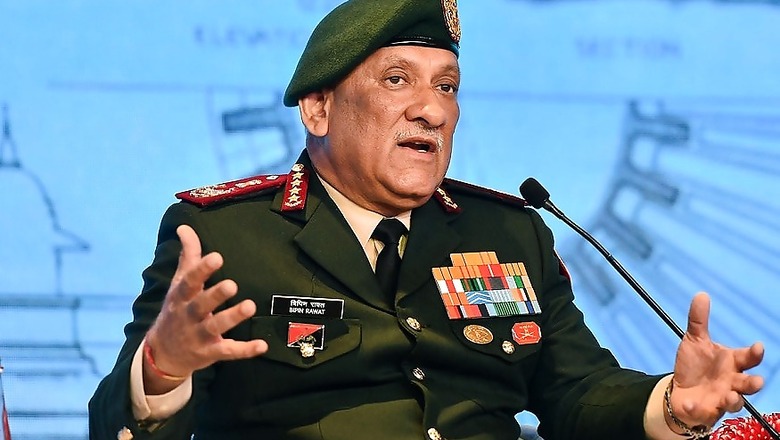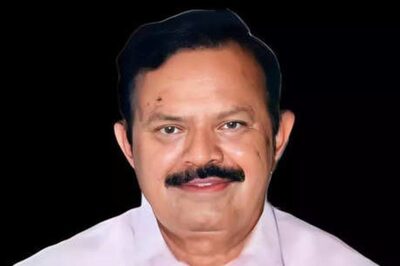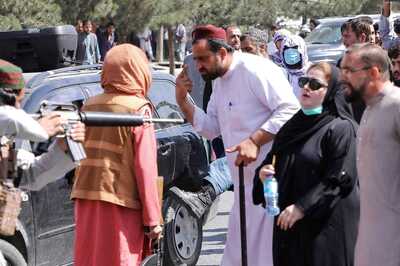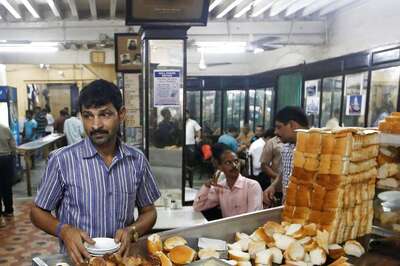
views
In his first interview since assuming the office of Chief of Defence Staff, Bipin Rawat spoke to CNN-News18 about defence budget, the need to acquire new equipments and his statement on deradicalisation camps for Kashmiri Youth among other issues.
You are one month into your new job as Chief of Defence Staff (CDS). What is the one big challenge you are facing? What is that one challenge you did not anticipate?
What I did not anticipate is the pace at which we will have to move forward. I think the government is very concerned that things must move on fast track. I am sure the government presumed that if defence services were asking for a CDS they would have done their basic homework. Therefore, all that the CDS would have to do is move on in what has been done already. But that is not the case, so we have had to start afresh and look at what lies ahead.
We are working on a 90-day or 100-day time frame and thereafter, in the first, second and third year, will identify the areas where we will bring about jointness – in operations, trainings, logistics and transportation. I think the timeline has been set very well and this is the biggest challenge.
When the post of CDS was announced by the PM everyone said General Rawat would get the appointment. Where you as confident?
I had planned life post retirement. In February, I was to go to the US to meet my sister. I had bought an open ticket in October, now I have lost money on that. I thought since the government has taken so much time in announcing a name for CDS , maybe they want to wait for 6 months, let the implementation committee streamline the mandate and then announce a name. . I have always said I was prepared for retirement after commanding my regiment. That was my ambition. God has been kind…imandaari se kaam kiya to gaadi chalti rahi..
When did you get to know?
On 31st December, the day i was to retire, I saw the news on the TV ticker. But the official call came from the Raksha Mantri.
You are the most visible face at the Defence Expo. There is a lot of military hardware and cutting-edge technology on display. But does India have the money to buy it, given the dismal defence budget it has?
We should not look at budget in monetary terms. We need to look at the budget in the management of the finances that are made available to us. I think we need to look at how the modernisation process of the Indian military has to move forward. It cannot happen overnight. If the government was to give you, let us say, two hundred thousand crore rupees today and said, ‘Okay, let us modernise in the next two years’, can we do it? It is not possible because things that we need for modernisation are not available in the open market. It’s not like going and buying bananas and oranges…you’re buying defence equipment. Even the most developed countries which produce these equipment don’t have the numbers that we look forward to introducing in our inventory.
There will be timelines over which you will be buying these things. I think the most important thing is see what you have in the budget, see what your priorities are and make sure that the three services move concurrently with modernisation. It is not lopsided modernisation, that is, one service going ahead leaving the other two services behind. Therefore, if you are going to have all the three services moving forward, the next issue I would like to highlight is, whenever you are procuring equipment, you must always stagger the purchase of all your equipment
For example, if you buy all the tanks that you require in the Indian Army, if you say, ‘I want to get a modern tank or a Future Ready Combat Vehicle (FRCV), and if you buy them over the three years, it will reach obsolescence in the next 15 to 20 years…30 years from now at the same time. The overhaul that will be due will all come at the same time. So I think you have to look at staggered purchases to ensure that the downtime of your equipment is not altogether down in one go.
You have to look at how to phase-out your downtime, and therefore, if you are looking at progressively building your systems and weaponry, you have to follow progressive timelines. So if I am looking at guns and tanks that are to be brought in, go over an eight to nine-year cycle. If the overall time of a tank is 10 to 12 years, then you should be making 10 to 15 purchases of that equipment every year. So that 10 years down the line, 10 to 15 per cent goes in for overhaul and not the entire batch.
At the same time, you have to see the capacities of overhaul within the country or the country who is to give you all these tanks (4.20-4.30). Can your overhaul your tanks in one go? No, so what happens is, if you buy everything in one go and they come up for overhaul at the same time, you will find that the capacity for overhaul is only 10 to 15 per cent in a year. Then you start falling back. Then you have equipment which is being overused without overhaul. This leads to misuse and further downgrading of the equipment.
So this issue of how to manage the budget…yes, budget can be managed. But we need to prioritise. In the last two to three years, we prioritised on purchase of equipment that we needed for infantry, we looked at artillery systems because artillery systems after Bofors had not been procured. And we said, ‘okay, this is high priority’. We looked at some of the obsolescence that had reached in the air defence systems…so we prioritised that.
When we started prioritising, we said, ‘okay, we’ve got the equipment and weapons, but where is the ammunition?’ What use is the weapon system, with the manpower available, if you don’t have the ammunition? So we decided to prioritise the procurement of ammunition.
I am happy when I hear from the service chiefs, ‘we are ready today’. What does it mean? They are ready today because they have something in the arsenal in stock. But when we prioritised, we started buying these weapon systems, we started buying the ammunition… something would have to take a hit. So what did we do? We made sure we went slow on our married accommodation project and construction of infrastructure…I’m not saying roads, I’m talking about headquarter buildings and accommodations for various other institutes and establishments. We went slow on these. We have not done anything of these kind in the last two to three years. But can we continue with that over the years? Therefore, we are working with the government to say, can we, for the married accommodation project and for the infra development, find funds from other means? Let me tell you, the Ministry of Defence has helped us in this regard. We are now going to adopt the New Moti Bagh model for building married accommodation houses and for the infrastructure development that we need the money for. Our aim is to get around Rs 35,000 crore over the next eight to 10 years to meet the requirements of our map and infra-development. That is how we are going about it. It is not from the defence money. WE MAY MONETIZE SOME PART OF DEFENSE LAND. Some of the land that is required for national construction effort, like National Highways Authority of India (NHAI) wants something or the state government want some land for development projects…we have that land available. We can give that land to those people, and instead of and that, we go in for infrastructure. That will help us with that problem.
Are you proposing to sell the defence land and downsize cantonments?
We are not selling defence land. For example, the Bharatmala roads (a central government scheme to build highways) are coming up, national highways are being developed. A very large number of these national highways go past our military stations, cantonments or defence land. When we give this land away, say instead of giving us money, which may or may not come to us, it is better you give us infrastructure in lieu.
We also find that a large number of our cantonments are in isolated pockets. We’ve got small pockets of land which have been given to us in various places. We do not need this land. For example, in Nagpur where we are now stationed, there are small pockets of land…half acre here, one acre there…we don’t need that land. This land is certainly going to be given away to the state government if it wants and take infrastructure in lieu.
What does ‘taking infrastructure in lieu’ mean in this context?
We ask state governments to evaluate the cost of land that we want. Once we know the cost of the land, we tell them, one house for a jawan costs us Rs 20 to 22 lakh and we need these many houses, so you build them for us…
I have very often heard that there is no surplus land with the armed forces. Well, we have got camping grounds , we have 13 grass birs in Gwalior. They are small penny pockets. Now when you make cantonments and stations in penny pockets, then security becomes a problem. Instead of doing that we would like to consolidate areas in one complex and give away the land which is in the fringes. It is prime land and it can be given away. But to say each time that every land that is held by the forces is defence land and therefore we need it…I don’t think we need all this land. We have to start looking at things differently.
There are two ordinance depots, one in Dehu Road (Pune) and one in Mumbai. What is the distance between the two? Do we need two ordinance depots so close by? Should they both exist or should one of them collapse? If one of them collapses, what do you do with the other? I would say, land is available, if you consolidate both these depots in one place, your security requirement goes down. Now we are securing both these depots with additional manpower. I’m also saying, please optimise your manpower…you can do a lot of things if you start consolidating your resources, your land requirements. And if you feel that the land can be made surplus, give it to the state governments or NHAI. I am not saying that we are selling that land. I’m saying, if anybody wants that land, we don’t mind getting infrastructure in lieu of that land.
You have spoken about the staggered approach for the Army. What about the Air Force? Does this logic also apply to the Air Force, given the fact that its squadron strength is down to 28?
If you bring all these squadrons to 42 today, at what stage will you again come to 30? Today you are 30, say you go to 42 in the next two years, 10 years down the line these aircrafts will be down for servicing wherever they are. What happens after 10 years? You are at minus twelve again. All of them will be due for servicing at the same time. Is that the way to do it?
Today you bought these 36 Rafales…you buy another 36 may be after four years. What will happen then is, you will never have the downtime. You will at any time have two to three squadrons undergoing servicing requirements. That’s what I am trying to say.
Even if the government tells you to go to 42 today…and you have the money… even if you have to buy 36 Rafales it will take three years to buy them. Where will you get them if you had to buy 10 more squadrons?
But the Indian Air Force is looking to buy more fighters. Is that buying on freeze?
No, it’s not on freeze. If a country that manufactures those aircraft is taking three years to give you those 36 aircraft, how will you get 12 squadrons overnight? They will also take 10 years then. It’s very nice to look at the figures but these are not available. Like I said before, we are not buying bananas and oranges. You are buying defence equipment and they cost thousands of crores. These thousands of crores worth of inventory is not lying captive with any manufacturer. He will only start manufacturing when you give him the orders. That is what it is. So we are not saying that we don’t need it…we need it but in what time frame? There for we need to stagger the requirement and keep moving forward. You cannot build 42 squadrons overnight even if the government gives you the money.
What about the Indian Navy’s requirement for a third aircraft carrier?
One aircraft carrier will be on the seas next year. You look at when do you really need a third one. If you get a third one, how many years will it take for it to develop? Even if you place the order for 2022 or 2023, it is not coming before 2033. Also, aircraft carrier is not just a carrier, along with it will have to come the aircraft. Where are the aircrafts coming from? Along with that we will need the armada protection for that aircraft carrier. It does not happen overnight. It will be bought if it is required… but you cannot predict what the situation will be 10 years from now. We don’t know what will happen.
Secondly, I would say, please also develop the capacities of your island territories. We have got island territories on our east coast and west coast. We need to develop these territories for extending our reach to the Indian Ocean region while we look at the aircraft carriers.
Are you saying we have sufficient budget for these?
I am not saying that the budget is less. But budget me paisa ja kaha raha hai…aap isko study kariyega. Where is the budget money going? Why are people not addressing the issue that I am most concerned about? Just between last year and this year, the pension budget has gone up from Rs 1.1 lakh crore to Rs 1.33 lakh crore. If it has gone to this limit, what is the increase annually? Can you sustain this budget annually with pensions?
Do you have a plan for sustaining this budget?
Yes, I do. Who has told you to dry a soldier so early? Why can’t you retire soldiers at the age of 58? Today, the officer retires at 58 and then looks forward to four years of reemployment. But he wants his soldier to go at 37. I’m not saying every soldier needs to serve till the age of 58 but why can’t people in the logistics serve till 58? You can go gradually from 50 to 54 years of age because if you suddenly go in for 58 as the age of retirement, your recruitment process will slow down. But you don’t want that.
Likewise, what are the people in army’s medical corps doing? Can they not serve till the age of 58? Can’t the people in the EME serve till 58? Can’t the people in Ordnance Corps serve till 58? Can’t the people in some of the arms, who are mainly vehicle-bound if even if they have to go for combat, serve till 58?
Now somebody will say, if we make 58 as the retirement age for jawans, how will they serve in Ladakh? They feel everybody who will serve there will be 58 years old. Are they saying that nobody will be between the age group of 20 and 45? If you are going to have people aged between 20 and 58, then I presume about 50% to 60% people will be aged between 20 and 45. Can’t you have a system in place where you say that till the time they are 45 years old they serve in these areas and when they cross 45, when their children also come of age – because we also have to look at the welfare of people – you get them to those areas which are relatively quiet and peaceful. You look at the base workshop. The base workshop has military and civilian people – more civilians than military. A military person retires early but a civilian serves till the age of 58. I have a third line ASC battalion which is used for stocking in Ladakh. The most difficult part is, from Pathankot to Leh, when these vehicles move day in and day out for six months when we do the stocking, there are civilian drivers on duty. What is their age of retirement? It’s 58. Why can’t a fauji driver serve till 58? In each infantry battalion, I can identify 50 people who can serve till 58. We have clerks who are office-bound. We have a lot of people who provide logistics support, we have cooks, hairdressers, cleaners, etc. There are at least 60% to 70% people in infantry battalions who can serve till the age of 58.
Will the management of pension give you enough money to modernise the forces?
What is happening today is that a jawan serves for 20 years and from the age of 40 he draws pension till he is 70. So he is serving for 20 years and receiving pension for 30 to 35 years, that is, if we consider he goes away at 70. I’m not saying that you don’t look after the jawan. You must look after him but you have to look after the combatant more than the others. What I am saying is, there is a combatant who has to retire at the age of 40 to 45. But why bust you treat every jawan as being unfit to work? Yes, there will be a jawan who will be termed unfit to work after the age of 40 but a very large number may not be unfit till 40 or even 45. So you let them go through a medical process and let all those chaps who are fit serve for a longer period depending on how long you want them to serve. Somehow all these comments are coming from the officers. I am not saying that the officers are comfortable with the salaries they are drawing and therefore with their pension. But when a jawan retires and his pension drops to half his income, he loses the free accommodation and ration, he loses the facility of school (for his children) that is next to his unit … Where does that jawan stand? He also needs to be looked after. Officers are talking about themselves. Please think about your men too.
If a jawan says I am willing to serve till 50 or 54 years of age, till my children get settled, and I will make sure I will remain physically fit, why can’t he be kept in the service? For every chap who retires, there is a new chap coming in.
Now let’s come to DSC. You must also think about defence security. The same jawan, who is being made to retire at 40 years of age, is expected to provide security at important places like the South Block, North Block and to all the DRDO establishments till the age of 58. So why can’t he serve and provide security in the service? We are losing a lot of good, technical manpower who we train but lose to the civilian companies. They are waiting for these people to come in at 40. Army has invested in them, trained them but now someone else is using them. They are getting trained manpower… I mean, who are we fooling!
Let’s talk about another of your mandates – military theater commands – when and how many?
Have I discussed the plan with the three chiefs? Informally and partially, yes. Formally, I have only discussed some of the theater commands. I intend to discuss them because I want to go step by step. I have a plan for 2020, 2021 and 2022. That is how I intend on moving. What I have said is, you take the low hanging fruit. I can create the the Air defence command straight away under the IAF. . I Feel cyber and space are moving forward. I can move on the integration of our logistics support system. After this we will see how we integrate commands. I want to first move in this direction and then look at that. But as I said, I am concerned about the 3 year timeline that has been set for me.
How many Theater Commands are you looking at?
It is how you look at it. Let us say, you’ve got Northern Front and you’ve got Western Front. You can deal with the Northern Front with two, and if you follow the Chinese model, you can make it one. If you look at Nepal as a dividing factor -- east of Nepal and west of Nepal – you can look at western theater. You can look at J&K as complete theater, including the IB sector, and you can look at the rest of western theater as another one. You can look at the Peninsula as well.
My mandate also says that you need to integrate training and logistics. Therefore, very broadly you have already come to the conclusion of 7. But that’s not the actual figure. I have not told you many more.
But you have 17 commands already. If you take the number of theater commands to 10, will it serve the purpose?
Hold on a moment…you have the eastern command and you have a command which is west of Nepal. You make it into one command. So you integrate these two and put a theater command. So you get three commanders – one west of Nepal and one theater to look after those. Now does this theater have to be senior to these commanders? What am I? I’m an equal.
There will be scope for conflict if that happens?
Why would there be a scope for conflict once you have decided who is first among equals? Even today, let us say, you decide on one theater command…he has been selected and recommended by the government.
The Air Force is not very keen on Theater Commands…they don't want to be the Army’s Air Force.
No, they don’t have to be. My Air Defence is going to become the Air Force’s Air Defence. Does the Air Force have a problem with that? Should the Army have a problem with that? There is no problem. If the army’s Air Defence is going under a theater command, commanded by, let us say for the time being, Air Force, where is the problem? They did not have this problem in Andaman and Nicobar where we have a theater command.
Have you reconsidered your statement on de-radicalisation camps in the Valley? We did not know such facilities existed in India
These facilities are available in Pakistan. I’ve got evidence. Tell me one thing, must you allow a person to be radicalised and then radicalised or you should be doing preventive radicalisation? We have got Army goodwill schools in the Valley. What are these? Why do we run these schools? Is it my task to run schools? Why am I running them? I am preventing some of these children from going adrift and getting radicalized.
Let me tell you the success story of Army goodwill schools. Not one child from these schools has so far become a stone thrower or joined terrorist ranks. Why did it happen? Because we prevented radicalisation. We also have an Army goodwill school in Pahalgam. It also has a boarding school. Some children of terrorist or over ground workers are studying there. Why have you brought them there? You felt that there was a scope of these people going astray and you are preventing that.
So you might call it de-radicalisation but I would say it is preventive radicalisation. These are not camps… I get a group of maulvis…not just me everybody before me got them, including those people who are talking today. When these people were in commanding positions in the Valley, they were sending groups of maulvis from the Valley on a ‘Sadbhavna Tour’ for 15 days. Why were you picking maulvis? What did you think the maulvis were? You felt that they were possibly the elements which were causing trouble and you wanted them to see the other side of the picture. You wanted them to go around, may be, Ajmer Sharif or Taj Mahal…you wanted them to see various masjids in Delhi and Lucknow. You showed them this and said, ‘yaha bhi aapke jaise maulvi hai. Aap suno unko. Aap kya kar rahe the?’ What was this?
Now, you brought them to a military station, they were kept with you all night and were traveling with you all night. Not for a minute were they allowed to go anywhere.
You can call it a camp but that’s why I say, ya toh angrezi seekh lo ya angrezi mat bolo. Main angrezi bolta hoon aur hindi bolta hoon. Padha main fortunately public school me hoon toh mujhe angrezi bhi aati hai or Hindi bhi aati hai. What is the meaning of a camp?
I am saying, ‘gentlemen, these are 5 children, okay you go to this camp. The other 10 children go to that camp. You are from this camp’. Now this camp does not become a detention centre. When I use the word camp, it means what? ‘You are Red House, you are Blue House, you are Green House. So one camp will do a study on democracy, one camp will do a study on dictatorship…that’s also called a camp. Any group that you make is a camp. Camp ka matlab military camp nahi hai. The word ‘camp’ can be used in different terms. Dictionary kholo toh pata lage.
So are you’re saying these Army goodwill schools actually act like de-radicalisation camps?
These are preventive radicalisation camps, not radicalisation camps. They are preventing radicalisation from happening. A child is staying with you for eight to nine hours. It is a gated school. You can call it a camp or not call it a camp. It’s a school. The school is giving goodness to the people.
How do you respond when people say General Rawat is very political? Why did you speak on the Anti-CAA protests?’
Call me political if you want. I was speaking at a leadership program. But tell me one thing, my Constitution tells me that I can protest. But where does the Constitution say that you can protest and be violent? I was giving a leadership talk… I said there are leaders … a leader is a person who leads. When you lead a group of people into carrying out an activity in a non-violent manner, but that group becomes violent, if you are still a leader, you should have the capacity to control them. If you can’t control them, you are not a leader, you have lost your leadership and then you become a mob.
Everyone has their views on the protest but what do you make of the current discourse calling anti CAA protesters Pakistanis and Terrorists?
It is better not to comment on this. What is happening is that one person makes one statement in anger. Then somebody makes another statement in anger. But these statements have started coming because of some anger among some people who are trying to vitiate the atmosphere so they come up with bigger and angrier and statements .
Are you justifying these statements?
I am not justifying it but what I am trying to say is, if a person is stealing.. who chhoti moti chori karta hai Now if one chap says, ‘toh kya ho gaya agar voh chhoti moti chori karta hai.. tu bhi woh ho gaya’…so have I said, ‘tu bhi chor ho gaya’? Usne sirf ye bola ki kya karta hai agar chhoti moti chori karta hai. I may be absolutely honest lekin kyunki maine yeh bol diya ki kya ho gaya agar usne yeh kar diya…do I become a chor? That is why you cannot compare.




















Comments
0 comment